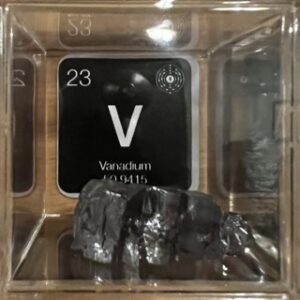Vanadium
Atomic Number: 23
Atomic Mass: 50.9415 u

Vanadium, a lesser-known but incredibly versatile element, plays a significant role in modern technology and industry. Represented by the symbol ‘V’ and atomic number 23 on the periodic table, vanadium is a medium-hard, steel-blue metal known for its strength and stability. This blog post will explore the unique properties of vanadium, its discovery, and the wide range of its applications in today’s world.
Understanding Vanadium
Discovered in 1801 by Spanish mineralogist Andrés Manuel del Río, vanadium was initially mistaken for a form of chromium. It wasn’t until 1831 that the element was correctly identified by Swedish chemist Nils Gabriel Sefström, who named it after Vanadis, the Scandinavian goddess of beauty, because of the beautiful colors of its compounds.
Key Uses of Vanadium
1. Steel and Alloys
The largest and most well-known use of vanadium is in the steel industry. Adding small amounts of vanadium to steel significantly increases its strength, toughness, and resistance to wear and corrosion. This makes vanadium steel ideal for a variety of applications, including:
- Reinforcement Bars: Used in the construction of buildings and bridges.
- Tool Steels: For making tools that are both strong and durable.
- Automobile Parts: In the manufacturing of gears, axles, and other critical components.
2. Aerospace Industry
In the aerospace industry, vanadium alloys are used to construct airframes and jet engines. Their high strength-to-weight ratio and ability to withstand high temperatures make them ideal for these applications.
3. Energy Storage
Vanadium is a key component in vanadium redox flow batteries (VRFBs), which are used for large-scale energy storage from renewable sources like solar and wind power. These batteries have several advantages, including scalability, long life cycles, and the ability to release energy quickly.
4. Chemical Industry
Vanadium is used as a catalyst in the production of sulfuric acid and in the manufacture of certain plastics and other chemicals. Its ability to speed up chemical reactions without being consumed makes it valuable in these processes.
5. Glass and Ceramics
Vanadium oxides are used in producing special types of glass and ceramics. They can provide color and also have properties that make them useful in applications like laser technology and optics.
6. Health and Biological Roles
While vanadium is not as well-known for its biological roles, it’s found in some enzymes and is being studied for potential health benefits and medicinal uses, including in the treatment of diabetes.
Environmental and Health Aspects
Vanadium must be handled carefully as some compounds can be toxic. Proper handling and disposal are essential to prevent environmental contamination. In terms of health, while the body needs trace amounts of vanadium for certain biological functions, excessive exposure can have harmful effects.
Conclusion
Vanadium’s unique properties and versatility make it an invaluable element in a wide range of modern applications. From strengthening steel to storing clean energy and catalyzing chemical reactions, vanadium is a quiet yet powerful force behind many of today’s technological advancements. As our understanding and application of this element continue to grow, so too will its significance in various industries, underscoring its role as an unsung hero of the periodic table.
Hello, young explorers! Today, let’s learn about a super cool element called vanadium. It might not be as famous as gold or silver, but it’s definitely just as interesting. Here are some fun facts about vanadium that will make you a mini-expert on this awesome element!
- Named After a Goddess: Vanadium is named after Vanadis, another name for Freyja, the Norse goddess of beauty, fertility, and love. It’s because the compounds of vanadium have beautiful colors!
- Color-changing Element: Vanadium can change colors! When mixed with different chemicals, it can turn into beautiful colors like blue, green, yellow, red, and even purple. It’s like a chameleon of the periodic table!
- Super Strong Steel: Vanadium is used to make super strong steel. Just a little bit of vanadium added to steel makes it much stronger and more durable. This kind of steel is used in cars, jet engines, and even in tools like wrenches and drills.
- Powering Up with Batteries: Vanadium is used in a special type of battery called the vanadium redox flow battery. These batteries are huge and can store a lot of energy, which is great for using solar and wind power.
- Space Travel: Because vanadium makes things strong but lightweight, it’s perfect for building space vehicles. Parts of spaceships and satellites often have vanadium in them.
- A Rainbow in Rocks: Vanadium isn’t found by itself in nature; it’s usually mixed in with other minerals and rocks. And when you find it, it can be a whole rainbow of colors!
- Healthy in Tiny Amounts: We all have a tiny bit of vanadium in our bodies. It’s not exactly clear what it does, but scientists think it might help with certain enzymes that are important for our cells.
- Glass and Pottery Magic: Vanadium is also used to make special kinds of glass and pottery. It can make them stronger and even add color to them.
- Discovered Twice: Vanadium was actually discovered twice! First, it was found in 1801 by a Spanish scientist, but people forgot about it. Then, in 1831, a Swedish scientist found it again and gave it the name vanadium.
- A Helping Hand in Nature: In nature, vanadium helps some sea creatures. There are some types of microorganisms and fungi that use vanadium in a similar way to how we use iron.
Isn’t vanadium fascinating? From making strong steel and colorful compounds to helping out in batteries and space travel, it’s an element that’s really worth knowing about. Keep an eye out for vanadium in the world around you – it’s doing a lot of important work! 🌈🚀🔋
In the element box, there are samples of Vanadium metal.
No media at this time.
 using WordPress and
using WordPress and
No responses yet